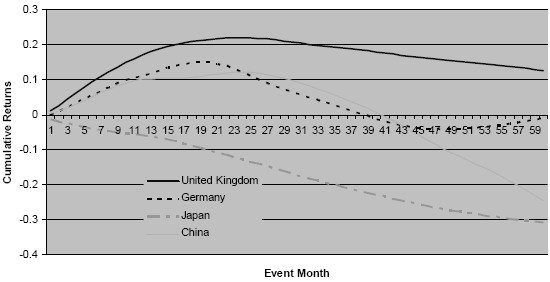Do momentum trading strategies work consistently across country markets? In his December 2008 paper entitled “Are Anomalies Still Anomalous? An Examination of Momentum Strategies in Four Financial Markets “, Daxue Wang applies various tests to measure the profitability of momentum strategies in the two largest stock markets in each of Europe (UK and Germany) and Asia (Japan and China). He tests overlapping equally weighted portfolios formed on returns over the past 3, 6, 9 or 12 months (no wait month) and held for 3, 6, 9 or 12 months. Using monthly stock price data and firm characteristics for companies comprising more than 95% of market capitalization in each country over the period 1990 (1994 for China) through 2006, he concludes that:
- Equity markets in the United Kingdom and Germany exhibit medium-term momentum for nearly all holding periods over the entire sample period and over subperiods, while Japan shows a medium-term return reversal for nearly all holding periods. China shows evidence of medium-term momentum for many holding periods.
- Specifically, monthly returns for the 16 equally weighted winner-minus-loser (top 10% minus bottom 10%) momentum strategies over the entire sample period range from:
- +0.19% to +1.75% per month in the UK, with 15 of 16 significantly positive.
- +0.53% to +1.24% per month in Germany, with 14 of 16 significantly positive.
- -0.02% to +1.11% per month in China, with 10 of 16 significantly positive.
- -0.71% to -0.02% per month in Japan, with 0 of 16 significantly positive and 9 of 16 significantly negative.
- For many strategies, momentum profits are significant after incorporating reasonable trading frictions.
- Like the U.S. market, momentum profits reverse for holding periods longer than about two years (see the chart below).
- Unlike the U.S. market, there is no January effect (temporary reversal) for momentum.
- The Fama-French three-factor model (market, size, book-to-market) does not explain momentum profits for most strategies.
The following chart, taken from the paper, compares the cumulative returns for equally weighted winner-minus-loser (top 10% minus bottom 10%) momentum portfolios in the UK, Germany, Japan and China formed on returns over the past six months and held for five years. Stocks included comprise over 95% of total market capitalization in each country. The graph for China is very faint, tracking close to that for Germany over the first four years. Cumulative returns for the UK, Germany and China peak after 18-24 months, with China exhibiting the most dramatic subsequent reversal. Japan shows an immediate and persistent reversal of past returns.

In summary, medium-term momentum investing may be profitable in most, but not all, international equity markets.